New : How a triode vacuum tube works
A relatively simple modification to the basic rectifier vacuum tube is responsible for many early radio transmitters and more. Here's how the triode, the next step in vacuum tubes, works. The triode allowed for switches and amplifiers to be made using a signal vacuum tube.
Before starting, here's an image of a triode, and the circuit schematic symbol for triodes:

Review: Vacuum Tube Rectifier
It's first necessary to understand the vacuum tube rectifier. This is the simplest vacuum tube, and I just wrote a post about it here, but if you don't want to read the whole thing the basics are as follows:
A metal filament and a metal terminal are separated by a vacuum gap. A battery heats up the filament until it glows, causing electrons to be ejected from the filament via a process called thermionic emission. Applying the positive terminal of a battery to the metal terminal and the negative terminal to the filament causes current to flow across the tube, bridging the circuit, via free electron charges. Reversing the polarity causes no current to flow, as electrons are attracted back into the positive filament. In this way, the simple vacuum tube rectifier acts as a diode and only allows current to flow in one direction.
The Triode
The triode was the next step for vacuum tubes. Imagine that we take a vacuum tube rectifier and put a metal, conductive mesh in between the filament and the terminal. Now if we connect a battery across the tube with the positive end on the terminal (the anode), current flows across the tube via electrons if the filament is heated up.
Applying a nonzero voltage to the mesh in between the cathode and anode will change how the electrons move. For example, applying a positive voltage to the mesh will attract more electrons, causing more charge to flow across the circuit and increase the current across the tube. Applying a negative voltage to the mesh will repel electrons, causing less to escape through the mesh and bridge the gap, reducing the overall current through the tube. In this way, the triode can be used as a switch. If you put a high negative voltage across the mesh, no electrons can pass, and you have effectively shut off the vacuum tube using only an electrical signal. Remove the voltage or apply a positive voltage to the mesh and current will once again flow. Now, with with the triode, you effectively have a vacuum tube diode that can be turned off, down, or up.
In this way, the triode can be used as a switch. If you put a high negative voltage across the mesh, no electrons can pass, and you have effectively shut off the vacuum tube using only an electrical signal. Remove the voltage or apply a positive voltage to the mesh and current will once again flow. Now, with with the triode, you effectively have a vacuum tube diode that can be turned off, down, or up.